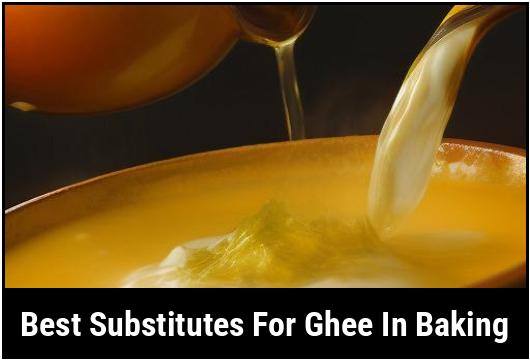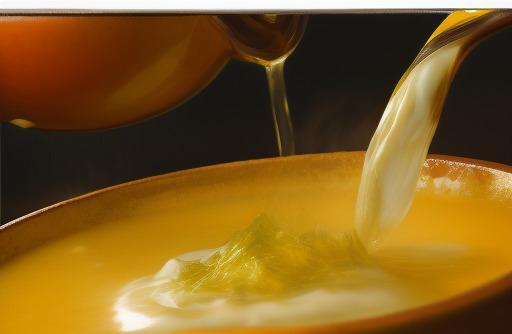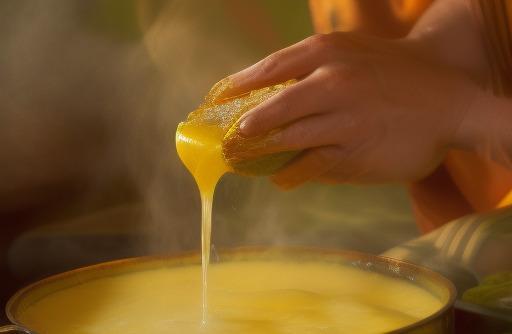- You are here:
- Home »
- Food Substitutes
- » Best Substitutes For Ghee In Baking
Best Substitutes For Ghee In Baking

Ghee, also known as clarified butter, is a popular ingredient in baking due to its rich, nutty flavor and creamy texture. However, ghee may not always be readily available or suitable for certain dietary preferences or restrictions. Luckily, there are several excellent substitutes for ghee that can be used in baking without compromising taste or texture. In this article, we will explore the best substitutes for ghee and provide helpful tips for using them in your favorite baking recipes.
Key Takeaways
- Ghee is a popular baking ingredient known for its rich flavor and creamy texture.
- There are several substitutes for ghee that can be used in baking, such as coconut oil, vegetable oil, and butter.
- When choosing a substitute for ghee, consider the flavor profile and melting point of the substitute.
- Use the same quantity of substitute as the amount of ghee called for in the recipe.
- Adjust the baking time and temperature as needed when using substitutes for ghee, as their properties may differ.
Why You Need A Substitute For Ghee In Baking
While ghee is a versatile baking ingredient, there are several reasons why you may need a substitute. Some common reasons include:
- Dietary Restrictions: Ghee is derived from milk and is therefore unsuitable for those with lactose intolerance or dairy allergies. In these cases, it is essential to find a suitable alternative that offers a similar taste and texture.
- Vegan or Plant-Based Diets: For those following a strict vegan or plant-based diet, ghee is not an option due to its animal-derived origin. Finding an alternative that replicates the rich flavor and texture is crucial for vegan baking.
- Availability: Depending on your location, ghee may not be easily accessible or readily available. Using a substitute that is easily found in your pantry can save you a trip to the store.
- Personal Preference: Some individuals may simply prefer the taste or texture of a substitute over ghee. It’s important to find a substitute that aligns with your personal preferences for a satisfying baking experience.
Types Of Substitutes For Ghee In Baking

When considering a substitute for ghee in baking, it’s essential to understand the various options available. Here are some common substitutes that can be used in baking:
- Coconut Oil: Coconut oil is a popular substitute for ghee in baking due to its similar texture and mild, nutty flavor. It works well in recipes that call for ghee because of its high fat content. Coconut oil is also suitable for vegan and dairy-free diets.
- Vegetable Oil: Vegetable oil, such as canola or sunflower oil, can be used as a substitute for ghee in baking. It is a neutral-tasting oil that does not alter the flavor of the final product. Vegetable oil is an excellent option for those with dietary restrictions or seeking a lighter alternative.
- Butter: Butter is a common substitute for ghee in baking, as it offers a similar flavor profile and creamy texture. However, it is important to note that butter contains a higher water content, which can affect the final texture of the baked goods. Adjustments may need to be made to the recipe to achieve the desired results.
- Margarine: Margarine can be used as a substitute for ghee in baking, especially in recipes that call for creaming the fat with sugar. However, it is important to choose a margarine with a high-fat content and avoid those that contain trans fats or hydrogenated oils.
- Nut Butters: Nut butters, such as almond butter or cashew butter, can be used as a substitute for ghee in baking. They add a rich, nutty flavor and provide a creamy texture to the baked goods. Nut butters are an excellent option for those who prefer a plant-based alternative.
Best Substitutes For Ghee In Baking
Now that we have explored the different types of substitutes for ghee in baking, let’s take a closer look at the best options available:
-
Coconut Oil:
- Coconut oil is an excellent substitute for ghee in baking due to its similar creamy texture and mild, nutty flavor.
- It works well in recipes that call for ghee, such as cookies, cakes, and bread.
- To use coconut oil as a substitute for ghee, use the same quantity called for in the recipe. It is important to note that coconut oil has a lower melting point than ghee, so adjust the baking time and temperature accordingly.
- Pro Tip: If you prefer a milder coconut flavor, look for refined coconut oil, which has a more neutral taste compared to unrefined coconut oil.
-
Vegetable Oil:
- Vegetable oil is a versatile substitute for ghee in baking, especially in recipes that require a neutral-flavored fat.
- It is a practical option for those with dietary restrictions or seeking a lighter alternative.
- Use the same quantity of vegetable oil as the amount of ghee called for in the recipe. Since vegetable oil is liquid at room temperature, it is important to consider its impact on the texture of the final baked goods.
- Pro Tip: When using vegetable oil as a substitute, consider reducing the overall liquid content in the recipe to account for the added moisture from the oil.
-
Butter:
- Butter is a classic substitute for ghee in baking, offering a similar flavor profile and creamy texture.
- It works well in recipes such as cookies, pastries, and pie crusts.
- Use the same quantity of butter as the amount of ghee called for in the recipe. However, keep in mind that butter contains a higher water content, which may affect the final texture of the baked goods.
- Pro Tip: To mimic the nutty flavor of ghee, consider browning the butter before using it in the recipe. Browning the butter adds a unique depth of flavor that can enhance the overall taste of the baked goods.
-
Margarine:
- Margarine can be used as a substitute for ghee, especially in recipes that require creaming the fat with sugar.
- Choose a margarine with a high-fat content and avoid those that contain trans fats or hydrogenated oils.
- Use the same quantity of margarine as the amount of ghee called for in the recipe. However, keep in mind that the flavor and texture of the final product may vary slightly.
- Pro Tip: Look for a non-hydrogenated margarine made with plant-based oils for a healthier alternative to ghee.
-
Nut Butters:
- Nut butters, such as almond butter or cashew butter, can add a rich, nutty flavor to baked goods as a substitute for ghee.
- They are particularly suitable for recipes like cookies, brownies, and energy bars.
- Use the same quantity of nut butter as the amount of ghee called for in the recipe. Keep in mind that nut butters can affect the overall texture of the baked goods due to their higher fat content.
- Pro Tip: Opt for smooth nut butters to ensure a smooth texture in the final baked goods. If using crunchy nut butter, it may be necessary to adjust the recipe to accommodate the texture.
Choosing The Right Substitute For Ghee In Baking

When choosing a substitute for ghee in baking, there are a few factors to consider:
- Flavor Profile: Consider the flavor profile of the substitute and how it will complement the other ingredients in the recipe. Coconut oil adds a subtle nutty flavor, while vegetable oil and butter have a more neutral taste.
- Melting Point: Ghee has a relatively high melting point, so it is important to choose a substitute with a similar melting point. Coconut oil and butter are solid at room temperature, while vegetable oil and margarine are liquid.
- Dietary Restrictions: Take into account any dietary restrictions or preferences you may have. For example, if you follow a vegan or plant-based diet, coconut oil or vegetable oil would be suitable substitutes.
- Texture: Consider how the substitute will affect the texture of the final baked goods. Butter and ghee have a higher water content compared to oils, which can impact the texture. Nut butters, on the other hand, add a creamy and nutty texture.
By considering these factors, you can choose the right substitute for ghee in your baking recipes to achieve the desired flavor and texture.
Cooking With Substitutes For Ghee In Baking
When using substitutes for ghee in baking, it is essential to make a few adjustments to ensure the best results:
- Quantity: Use the same quantity of substitute as the amount of ghee called for in the recipe. This will help maintain the balance of flavors and textures.
- Melting Point: Consider the melting point of the substitute and adjust the baking time and temperature accordingly. Coconut oil and butter are solid at room temperature, while vegetable oil and margarine are liquid.
- Texture: Keep in mind that different substitutes may have an impact on the texture of the final baked goods. Experiment with recipes and adjust as necessary to achieve the desired texture.
- Flavor: Take into account the flavor profile of the substitute and how it will affect the overall taste of the baked goods. Some substitutes may add a subtle nutty flavor, while others are more neutral.
By making these adjustments, you can successfully use substitutes for ghee in your baking recipes without compromising taste or texture.
Recipes Using Substitutes For Ghee In Baking

Here are two delicious recipes that showcase the use of substitutes for ghee in baking:
Vegan Chocolate Chip Cookies
Ingredients:
- 1/2 cup coconut oil, melted
- 3/4 cup brown sugar
- 1/4 cup almond butter
- 2 teaspoons vanilla extract
- 1 1/2 cups all-purpose flour
- 1/2 teaspoon baking soda
- 1/4 teaspoon salt
- 1 cup dairy-free chocolate chips
Instructions:
- Preheat the oven to 350°F (175°C) and line a baking sheet with parchment paper.
- In a large bowl, combine the melted coconut oil, brown sugar, almond butter, and vanilla extract. Mix well until smooth and creamy.
- In a separate bowl, whisk together the flour, baking soda, and salt. Gradually add the dry ingredients to the wet ingredients and mix until just combined.
- Fold in the dairy-free chocolate chips.
- Using a cookie scoop or tablespoon, drop rounded dough onto the prepared baking sheet. Flatten each cookie slightly with the back of a fork.
- Bake for 10-12 minutes, or until the edges are golden brown.
- Remove from the oven and let the cookies cool on the baking sheet for a few minutes before transferring them to a wire rack to cool completely.
- Enjoy the vegan chocolate chip cookies with your favorite plant-based milk or beverage.
Classic Butter Cake
Ingredients:
- 1 cup unsalted butter, softened
- 2 cups granulated sugar
- 4 large eggs
- 2 teaspoons vanilla extract
- 3 cups all-purpose flour
- 1 tablespoon baking powder
- 1/2 teaspoon salt
- 1 cup milk
Instructions:
- Preheat the oven to 350°F (175°C) and prepare two 9-inch round cake pans by greasing and flouring them.
- In a large mixing bowl, cream together the softened butter and granulated sugar until light and fluffy.
- Add the eggs one at a time, beating well after each addition. Stir in the vanilla extract.
- In a separate bowl, whisk together the flour, baking powder, and salt.
- Gradually add the dry ingredients to the butter mixture, alternating with the milk. Begin and end with the dry ingredients, mixing well after each addition.
- Pour the batter evenly into the prepared cake pans.
- Bake for 25-30 minutes, or until a toothpick inserted into the center of the cakes comes out clean.
- Remove the cakes from the oven and let them cool in the pans for 10 minutes. Then, transfer them to a wire rack to cool completely before frosting.
- Decorate and frost the cakes with your favorite buttercream frosting or frosting of choice.
- Enjoy a slice of this classic butter cake with a hot cup of tea or coffee.
These recipes demonstrate how substitutes for ghee can be seamlessly incorporated into your baking routine, providing delicious results that cater to various dietary preferences.
Storage And Shelf Life Of Substitutes
The storage and shelf life of substitutes for ghee will vary depending on the type of substitute used. Here are some general guidelines to keep in mind:
- Coconut oil: Store coconut oil in a cool, dark place, away from direct sunlight. It has a long shelf life and can typically be stored for up to two years. It can solidify at cooler temperatures, but will melt again when heated.
- Vegetable oil: Vegetable oil should be stored in a cool, dark place, away from heat and light. It can be stored for up to six months. Be sure to check the expiration date on the bottle before use.
- Butter: Butter should be stored in the refrigerator, tightly wrapped or in an airtight container. It can typically be stored for up to three months in the fridge. If stored in the freezer, it can last up to six months.
- Margarine: Margarine should be stored in the refrigerator or freezer, depending on the specific product. It is best to follow the storage instructions provided on the packaging.
- Nut butters: Nut butters, once opened, should be stored in the refrigerator to prevent spoilage. They can typically be stored for up to three months in the fridge, but check the expiration date on the jar for guidance.
It is important to always check the storage instructions provided by the manufacturer for each specific substitute to ensure optimal quality and freshness.
Conclusion
Finding a suitable substitute for ghee in baking is essential for those with dietary restrictions or unique preferences. By exploring the various substitutes available, such as coconut oil, vegetable oil, butter, margarine, and nut butters, you can continue to enjoy your favorite baked goods without compromising taste or texture. Remember to consider the flavor profile, melting point, and dietary requirements of each substitute when making your selection. With a little experimentation and adjustment, you can successfully incorporate substitutes for ghee into your baking repertoire for delicious results every time.
FAQS
What Is Ghee And Why Would Someone Need A Substitute For It In Baking?
Ghee is a type of clarified butter commonly used in Indian cuisine. However, it is not suitable for those who are lactose intolerant or vegan. Thus, finding an appropriate replacement for ghee is necessary for certain dietary and ethical restrictions.
What Are The Best Substitutes For Ghee In Baking?
Coconut oil, avocado oil, nut butter, and vegetable oil are the most common substitutes for ghee in baking. Each of these options may have a different taste and consistency but can produce similar results when used correctly.
Can I Substitute Margarine For Ghee In Baking?
While margarine is a similar texture to ghee and can be used to replace it in many recipes, it is often made from partially hydrogenated oils and has a higher content of unhealthy trans fats. Therefore, it’s recommended to avoid margarine in baking and stick to healthier options like the ones mentioned above.
How Do I Decide Which Substitute For Ghee To Use In My Recipe?
The type of substitute you choose will depend on the recipe you are baking. For example, if you are looking for a nutty flavor, a nut butter like almond or peanut butter may be the best option. On the other hand, if you are looking for a mild taste, coconut oil or avocado oil might be a better choice.
Will Using A Substitute For Ghee Affect The Texture And Taste Of The Final Product?
Using a substitute instead of ghee may slightly change the taste and texture of your baked good as each substitute has its unique flavor and consistency. However, it should not significantly affect the quality of your final product if used in moderation and with care. It is important to note that experimentation may be needed to find the most suitable substitute for your recipe.
Sources
About the Author Jenny
I'm Jenny, a housewife with an unwavering passion for food. My culinary journey began with my grandmother's kitchen, and it's now a full-fledged food blog. I've turned my love for cooking into a creative outlet, sharing recipes and stories with a global community of fellow food enthusiasts. It's proof that being a housewife can also mean pursuing your passions and savoring life's delectable moments.
